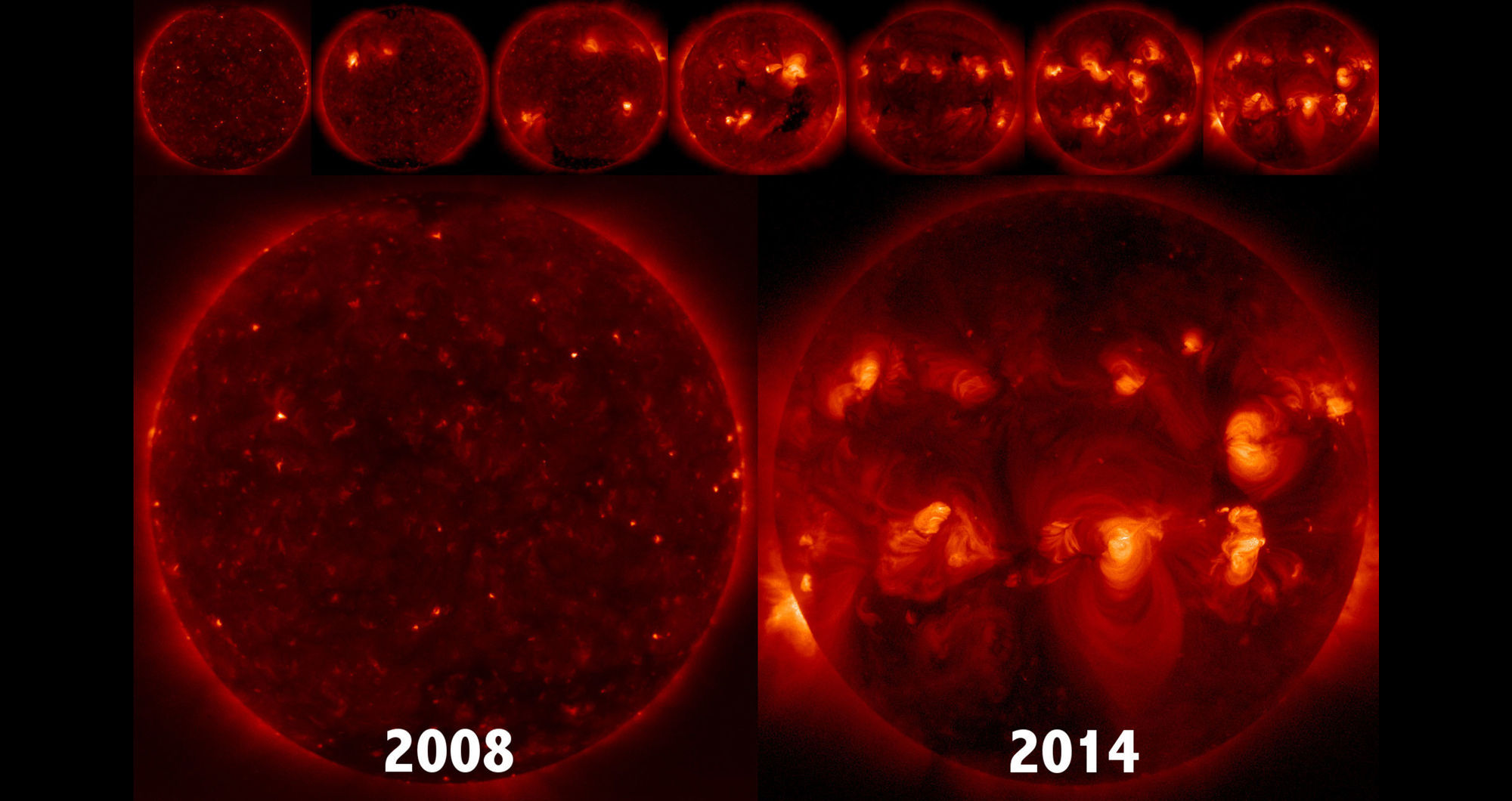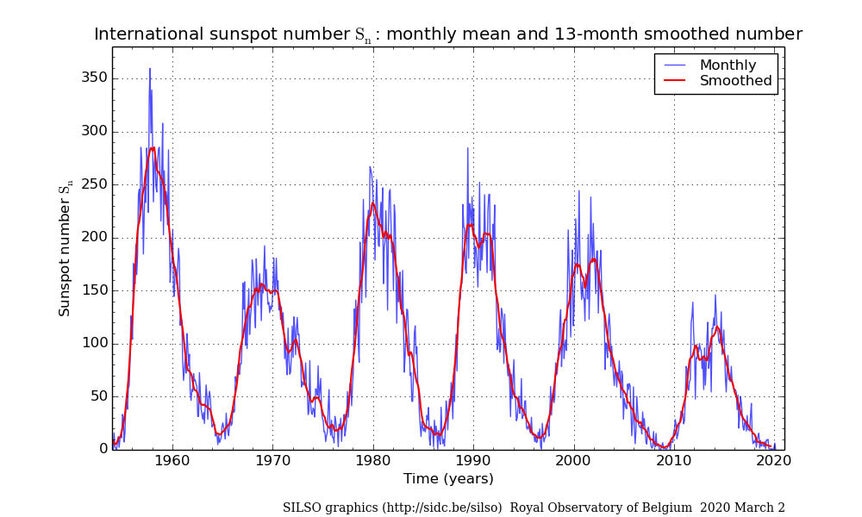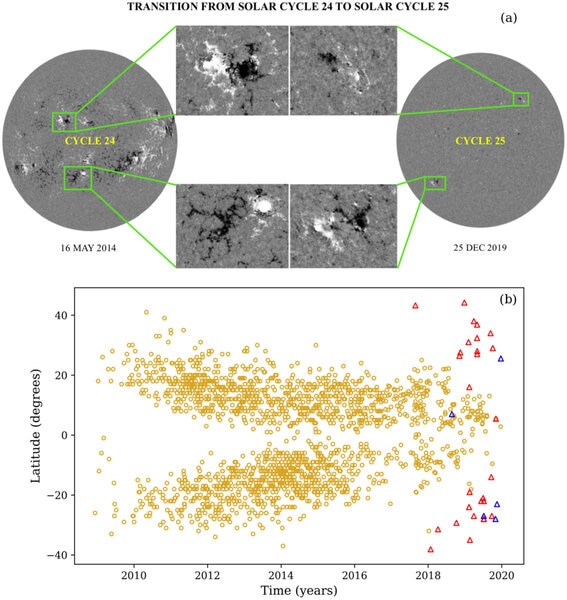Create a free profile to get unlimited access to exclusive videos, sweepstakes, and more!
Welcome Cycle 25! A new solar magnetic cycle has begun.

The Sun has been quiet for a long time, but that is finally changing. The last peak of magnetic activity for our star was in 2014-2015 and it's declined to basically nothing since then, but new research indicates it's on the upswing again.
The Sun has a complicated magnetic field, to say the least. The Earth's is relatively simple, like a big dipole bar magnet on the large scale (though on the small scale it's way more complex). But the Sun doesn't really have a large scale-organized field; instead it has zillions of little fields that all form deep inside it.
This is tied with convection in the Sun. Down near the core, where the energy is generated, conditions in the Sun become such that energy is transported by parcels of superhot ionized gas (called plasma) rising due to buoyancy. This creates huge, towering conveyor belts of plasma moving up and down inside the Sun, reaching all the way to the surface.
But, a basic rule of physics says that moving charged particles create a magnetic field. So each one of these convection cells has its own magnetic field… and there are a lot of these cells inside the Sun. Thousands.
For reasons still not well understood, the Sun's magnetic field waxes and wanes on an 11-year cycle, strengthening to a peak then dropping down to a minimum about 5.5 years later, only to strengthen once again. Not only that, but after one of those minima the next maximum has the opposite polarity, switching the magnetic north and south poles. So really the complete cycle is 22 years, a double cycle including the polarity swaps.
Like I said: It's complicated.
When the magnetism is near its peak we start to see lots of activity on the Sun's surface. Magnetic field lines from various convection cells can become entangled, and if they snap they can release huge blasts of energy called solar flares. These can also trigger even bigger coronal mass ejections (CMEs), where billions of tons of hydrogen can get launched into space at huge velocities.
And all of these are associated with sunspots: Dark regions on the surface. These are due to the magnetic field lines embedded in the gas keeping that gas from sinking back into the Sun once it cools. Cooler gas doesn't emit as much light, so they appear dark. They're actually still really hot, just not quite as hot as surrounding gas, so they look dark by contrast.
Sunspots are tracers of solar magnetic activity then. During a maximum there can be dozens on the face of the Sun, and during a minimum they can drop to zero. That's where we are now; there have been very few spots at all for the past few years.
Which finally brings me back to the topic here: That looks like it's about to change. Astronomers looked at the Sun using an instrument on the space-based Solar Dynamics Observatory called the Helioseismic and Magnetic Imager. Magnetic fields affect the light leaving the Sun's surface (polarizing it) in a way that can be used to measure the strength and even the polarity of those fields.
They looked at a bunch of different regions on the Sun to measure their magnetic polarity. Remember, each cycle from the Sun has the opposite polarity as the last one; in this case the last one that peaked in 2015 or so is called Cycle 24, and the next one that will be flipped is called Cycle 25.
Using HMI, they found 33 different regions on the Sun's surface conforming to the expected polarity of Cycle 25. Moreover, these regions were generally at high latitudes, nearer the Sun's poles. That's where the first magnetic regions tend to appear in a new cycle; they start forming at high latitudes and then over the next few years form at lower latitudes. This is called a solar butterfly diagram due to the shape of the curve you get when you graph their locations over time.
They therefore conclude that Cycle 25 is finally getting itself started inside the Sun, and we'll return to a period of higher solar activity as a result.
I'll note that this is more than just of academic interest. Way more: Flares and CMEs are extraordinarily violent events, and they can directly affect the Earth. Flares generate X- and gamma rays that can create electromagnetic pulses inside satellites, damaging or even destroying them. CMEs carry their own magnetic fields with them, and when they sweep over the Earth their fields can couple with ours, causing all kinds of havoc like huge electric currents inside the Earth that can cause power outages over large regions (Quebec had a wide-scale blackout in 1989 due to a large CME). A huge storm in 2012 just missed the Earth, but had it hit it would've had catastrophic and global effects. And solar astronomers just determined these happen more often than we used to think.
The last cycle, number 24, was relatively weak (despite that one huge 2012 blast). The one before that which peaked in 2003 created a series of ridiculously powerful flares that took astronomers by surprise, so energetic they went right off the scale. We can't predict exactly when a cycle will peak, how powerful it will be, or what kind of activity it will produce. But with these new tools like HMI we're starting to get a better handle on other aspects of them.
And, like everything in science, these are all pieces of a giant puzzle. The more pieces we have to see, the better we can fit them together. There may come a time when we can predict what the Sun will do, maybe even far enough in advance to help gird ourselves against it. Those first steps are being taken now.
So let's see what Cycle 25 has in store for us. Hopefully it'll be relatively mild, and we'll have that much more time to prep for any issues. But another active and powerful cycle is coming, if not this time then eventually. The better we understand the Sun, the better off we'll be.




























